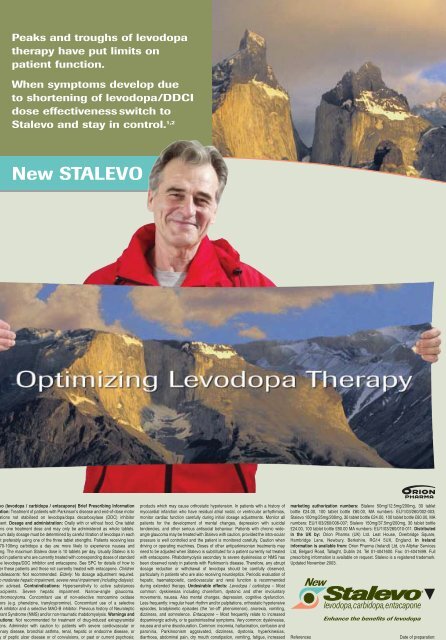Download - Advances in Clinical Neuroscience and Rehabilitation
Download - Advances in Clinical Neuroscience and Rehabilitation
Download - Advances in Clinical Neuroscience and Rehabilitation
You also want an ePaper? Increase the reach of your titles
YUMPU automatically turns print PDFs into web optimized ePapers that Google loves.
Peaks <strong>and</strong> troughs of levodopa<br />
therapy have put limits on<br />
patient function.<br />
When symptoms develop due<br />
to shorten<strong>in</strong>g of levodopa/DDCI<br />
dose effectiveness switch to<br />
Stalevo <strong>and</strong> stay <strong>in</strong> control. 1,2<br />
New STALEVO<br />
Stalevo (levodopa / carbidopa / entacapone) Brief Prescrib<strong>in</strong>g Information<br />
Indication: Treatment of patients with Park<strong>in</strong>son’s disease <strong>and</strong> end-of-dose motor<br />
fluctuations not stabilised on levodopa/dopa decarboxylase (DDC) <strong>in</strong>hibitor<br />
treatment. Dosage <strong>and</strong> adm<strong>in</strong>istration: Orally with or without food. One tablet<br />
conta<strong>in</strong>s one treatment dose <strong>and</strong> may only be adm<strong>in</strong>istered as whole tablets.<br />
Optimum daily dosage must be determ<strong>in</strong>ed by careful titration of levodopa <strong>in</strong> each<br />
patient preferably us<strong>in</strong>g one of the three tablet strengths. Patients receiv<strong>in</strong>g less<br />
than 70-100mg carbidopa a day are more likely to experience nausea <strong>and</strong><br />
vomit<strong>in</strong>g. The maximum Stalevo dose is 10 tablets per day. Usually Stalevo is to<br />
be used <strong>in</strong> patients who are currently treated with correspond<strong>in</strong>g doses of st<strong>and</strong>ard<br />
release levodopa/DDC <strong>in</strong>hibitor <strong>and</strong> entacapone. See SPC for details of how to<br />
transfer these patients <strong>and</strong> those not currently treated with entacapone. Children<br />
<strong>and</strong> adolescents: Not recommended. Elderly: No dosage adjustment required.<br />
Mild to moderate hepatic impairment, severe renal impairment (<strong>in</strong>clud<strong>in</strong>g dialysis):<br />
Caution advised. Contra<strong>in</strong>dications: Hypersensitivity to active substances<br />
or excipients. Severe hepatic impairment. Narrow-angle glaucoma.<br />
Pheochromocytoma. Concomitant use of non-selective monoam<strong>in</strong>e oxidase<br />
<strong>in</strong>hibitors (e.g. phenelz<strong>in</strong>e, tranylcyprom<strong>in</strong>e). Concomitant use of a selective<br />
MAO-A <strong>in</strong>hibitor <strong>and</strong> a selective MAO-B <strong>in</strong>hibitor. Previous history of Neuroleptic<br />
Malignant Syndrome (NMS) <strong>and</strong>/or non-traumatic rhabdomyolysis. Warn<strong>in</strong>gs <strong>and</strong><br />
precautions: Not recommended for treatment of drug-<strong>in</strong>duced extrapyramidal<br />
reactions. Adm<strong>in</strong>ister with caution to: patients with severe cardiovascular or<br />
pulmonary disease, bronchial asthma, renal, hepatic or endocr<strong>in</strong>e disease, or<br />
history of peptic ulcer disease or of convulsions, or past or current psychosis;<br />
patients receiv<strong>in</strong>g concomitant antipsychotics with dopam<strong>in</strong>e receptor-block<strong>in</strong>g<br />
properties, particularly D2 receptor antagonists; patients receiv<strong>in</strong>g other medic<strong>in</strong>al<br />
products which may cause orthostatic hypotension. In patients with a history of<br />
myocardial <strong>in</strong>farction who have residual atrial nodal, or ventricular arrhythmias,<br />
monitor cardiac function carefully dur<strong>in</strong>g <strong>in</strong>itial dosage adjustments. Monitor all<br />
patients for the development of mental changes, depression with suicidal<br />
tendencies, <strong>and</strong> other serious antisocial behaviour. Patients with chronic wideangle<br />
glaucoma may be treated with Stalevo with caution, provided the <strong>in</strong>tra-ocular<br />
pressure is well controlled <strong>and</strong> the patient is monitored carefully. Caution when<br />
driv<strong>in</strong>g or operat<strong>in</strong>g mach<strong>in</strong>es. Doses of other antipark<strong>in</strong>sonian treatments may<br />
need to be adjusted when Stalevo is substituted for a patient currently not treated<br />
with entacapone. Rhabdomyolysis secondary to severe dysk<strong>in</strong>esias or NMS has<br />
been observed rarely <strong>in</strong> patients with Park<strong>in</strong>son’s disease. Therefore, any abrupt<br />
dosage reduction or withdrawal of levodopa should be carefully observed,<br />
particularly <strong>in</strong> patients who are also receiv<strong>in</strong>g neuroleptics. Periodic evaluation of<br />
hepatic, haematopoietic, cardiovascular <strong>and</strong> renal function is recommended<br />
dur<strong>in</strong>g extended therapy. Undesirable effects: Levodopa / carbidopa – Most<br />
common: dysk<strong>in</strong>esias <strong>in</strong>clud<strong>in</strong>g choreiform, dystonic <strong>and</strong> other <strong>in</strong>voluntary<br />
movements, nausea. Also mental changes, depression, cognitive dysfunction.<br />
Less frequently: irregular heart rhythm <strong>and</strong>/or palpitations, orthostatic hypotensive<br />
episodes, bradyk<strong>in</strong>etic episodes (the ‘on-off’ phenomenon), anorexia, vomit<strong>in</strong>g,<br />
dizz<strong>in</strong>ess, <strong>and</strong> somnolence. Entacapone – Most frequently relate to <strong>in</strong>creased<br />
dopam<strong>in</strong>ergic activity, or to gastro<strong>in</strong>test<strong>in</strong>al symptoms. Very common: dysk<strong>in</strong>esias,<br />
nausea <strong>and</strong> ur<strong>in</strong>e discolouration. Common: <strong>in</strong>somnia, halluc<strong>in</strong>ation, confusion <strong>and</strong><br />
paroniria, Park<strong>in</strong>sonism aggravated, dizz<strong>in</strong>ess, dystonia, hyperk<strong>in</strong>esias,<br />
diarrhoea, abdom<strong>in</strong>al pa<strong>in</strong>, dry mouth constipation, vomit<strong>in</strong>g, fatigue, <strong>in</strong>creased<br />
sweat<strong>in</strong>g <strong>and</strong> falls. See SPC for details of laboratory abnormalities, uncommon<br />
<strong>and</strong> rare events. Legal category: POM. Presentations, basic NHS costs <strong>and</strong><br />
market<strong>in</strong>g authorization numbers: Stalevo 50mg/12.5mg/200mg, 30 tablet<br />
bottle £24.00, 100 tablet bottle £80.00, MA numbers: EU/1/03/260/002-003;<br />
Stalevo 100mg/25mg/200mg, 30 tablet bottle £24.00, 100 tablet bottle £80.00, MA<br />
numbers: EU/1/03/260/006-007; Stalevo 150mg/37.5mg/200mg, 30 tablet bottle<br />
£24.00, 100 tablet bottle £80.00 MA numbers: EU/1/03/260/010-011. Distributed<br />
<strong>in</strong> the UK by: Orion Pharma (UK) Ltd. Leat House, Overbridge Square,<br />
Hambridge Lane, Newbury, Berkshire, RG14 5UX, Engl<strong>and</strong>. In Irel<strong>and</strong><br />
<strong>in</strong>formation is available from: Orion Pharma (Irel<strong>and</strong>) Ltd, c/o Allphar Services<br />
Ltd, Belgard Road, Tallaght, Dubl<strong>in</strong> 24. Tel 01-4041600. Fax: 01-4041699. Full<br />
prescrib<strong>in</strong>g <strong>in</strong>formation is available on request. Stalevo is a registered trademark.<br />
Updated November 2003.<br />
References<br />
Date of preparation:<br />
1. Larsen JP et al. Eur J Neur 2003;10:137-146. December 2003<br />
2. R<strong>in</strong>ne UK et al. Neurology 1998;51:1309-1314. STA1016

















